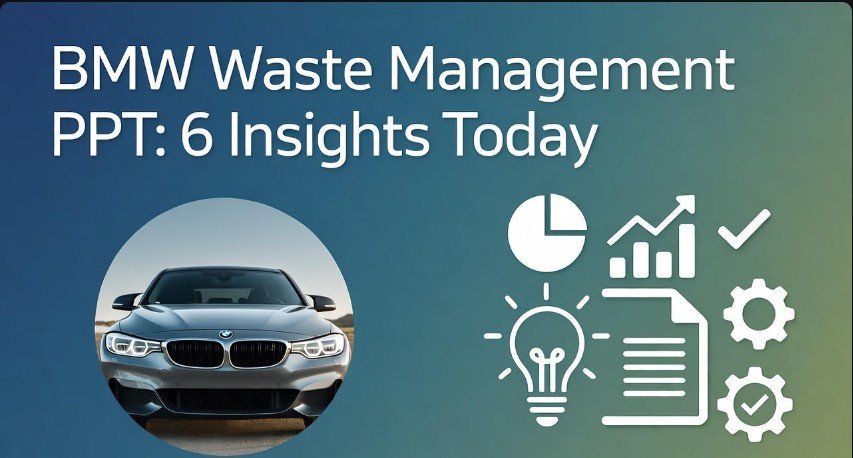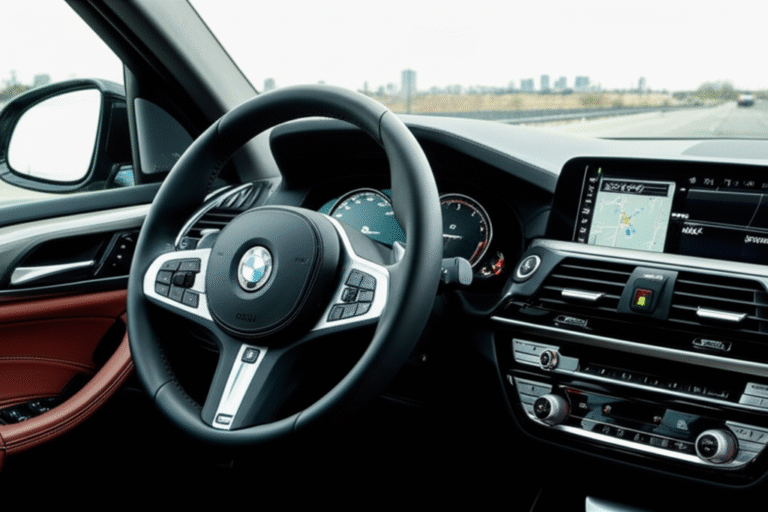BMW Waste Management PPT: 6 Insights Today

Navigate BMW Waste Management with 6 Essential Insights from Today’s PPT. Understand eco-friendly practices for your luxury vehicle, ensuring compliance and sustainability.
Key Takeaways
- Understand BMW’s commitment to sustainable automotive practices.
- Discover innovative BMW waste reduction methods.
- Learn about recycling and material reuse in BMW production.
- Explore BMW’s energy efficiency and emissions control.
- Identify BMW’s role in the circular economy.
- Grasp the future of eco-conscious BMW ownership.
Owning a BMW is a statement of innovation and luxury. But have you ever wondered about the environmental footprint behind such engineering marvels? Understanding BMW waste management is crucial, not just for the company, but for us as owners. It can seem complex, but it’s more accessible than you think. This guide will break down key insights, drawing from current presentations and industry knowledge. We’ll steer you through what makes BMW a leader in sustainability. Let’s explore what makes BMW’s approach to waste management so noteworthy today.
Why BMW Waste Management Matters in the USA

In the United States, car manufacturers and consumers alike are increasingly focused on environmental responsibility. Regulatory bodies, like the Environmental Protection Agency (EPA), set stringent standards for emissions and waste disposal. For luxury brands like BMW, maintaining a reputation for quality also means upholding a commitment to sustainability. This isn’t just about compliance; it’s about aligning with the values of a growing segment of environmentally conscious drivers across the USA. Understanding BMW’s waste management strategies gives you insights into the brand’s dedication to a cleaner future and how your vehicle contributes to it.
Insight 1: BMW’s Holistic Approach to Sustainability
BMW’s commitment to sustainability starts from the ground up. It’s not merely about handling waste after it’s created; it’s about preventing waste in the first place. This involves a comprehensive strategy that touches every phase of a vehicle’s lifecycle: design, production, use, and end-of-life.
Eco-Design Principles
BMW employs eco-design principles from the earliest stages of vehicle development. This means selecting materials that are recyclable, durable, and manufactured with minimal environmental impact. Designers consider the entire lifecycle, aiming to reduce the need for hazardous substances and to make disassembly easier for recycling at the end of a car’s life. For example, they focus on using lighter materials that improve fuel efficiency, thereby reducing emissions during the vehicle’s operational life.
Sustainable Production Processes
Manufacturing facilities in the USA and globally are designed with efficiency and waste reduction as core tenets. This includes optimizing energy consumption, water usage, and reducing waste generated on the assembly line. BMW aims for closed-loop systems where possible, meaning materials used in production are recycled and reused within the same plant.
Lifecycle Assessment (LCA)
BMW utilizes Lifecycle Assessment (LCA) to measure the environmental impact of their vehicles from raw material extraction to disposal. This detailed analysis helps identify areas for improvement, ensuring that sustainability efforts are focused where they will have the greatest effect. For instance, an LCA might reveal that sourcing a particular component locally significantly reduces its carbon footprint compared to importing it, even if the local manufacturing process is slightly less efficient.
Insight 2: Innovative Material Recycling and Reuse
A significant aspect of BMW waste management PPT discussions revolves around the clever use and recycling of materials. The automotive industry, especially for luxury vehicles, uses a complex array of materials, and BMW is at the forefront of finding sustainable solutions for them.
Aluminum and Steel Recycling
Aluminum and steel are primary materials in vehicle construction. BMW has invested heavily in processes to recycle these metals. Scrap metal from production lines is melted down and reused in new car parts. This not only conserves resources but also significantly reduces the energy required compared to producing virgin metals. The company often highlights its efforts in these areas, showcasing how efficient recycling can contribute to a lower overall environmental impact.
Plastics and Composites
Modern vehicles contain a large number of plastic and composite components. BMW is developing advanced recycling techniques for these materials. ‘Enviro-friendly’ plastics are being introduced, which are easier to process and recycle. In some cases, recycled plastics are integrated back into the manufacturing of interior components or underbody panels. This helps divert waste from landfills and reduces the reliance on petroleum-based virgin plastics.
Battery Recycling
With the increasing popularity of electric and hybrid BMW models, battery recycling is a critical focus. BMW is collaborating with specialized partners to develop efficient and safe methods for recycling high-voltage batteries. This process aims to recover valuable raw materials like cobalt, lithium, and nickel, which can then be used to manufacture new batteries. This closed-loop approach is vital for the sustainability of electric mobility.
Insight 3: Energy Efficiency and Emissions Control
Beyond material waste, energy consumption and emissions during production are major concerns. BMW’s waste management strategies extend to minimizing its environmental impact in these areas.
Renewable Energy Sources
Many of BMW’s manufacturing plants, including those in the USA, are increasingly powered by renewable energy sources. This includes solar power, wind energy, and the use of biofuels. By transitioning to cleaner energy, BMW significantly reduces its carbon footprint and operational waste in the form of greenhouse gas emissions. The company has set ambitious targets for increasing its use of renewable energy across its global operations.
Water Management
Water is a vital resource in manufacturing. BMW implements sophisticated water management systems to reduce consumption and ensure responsible wastewater treatment. This includes recycling process water and treating any discharged water to meet or exceed environmental standards. Such practices are especially important in regions like the USA where water scarcity can be a concern.
Lean Manufacturing principles
The adoption of lean manufacturing principles helps eliminate waste in all forms, including time, inventory, and motion. By streamlining production processes, BMW not only increases efficiency but also reduces the generation of waste and the consumption of energy. This philosophy permeates the entire organization, from the factory floor to administrative offices.
Insight 4: BMW’s Circular Economy Strategy
The concept of a circular economy is central to BMW’s long-term sustainability vision. Instead of the traditional linear “take-make-dispose” model, BMW aims to keep resources in use for as long as possible, extracting maximum value from them.
Designing for Disassembly
Vehicles are increasingly designed with end-of-life in mind. This means designing components and the overall vehicle structure to be easily disassembled. This facilitates the recovery of valuable materials and components for reuse or recycling, minimizing landfill waste. For example, using fewer adhesives and more mechanical fasteners can simplify disassembly.
Remanufacturing and Refurbishment
BMW offers remanufacturing programs for certain parts. This involves taking used components, rebuilding them to original specifications, and offering them with the same warranty as new parts. This is a more resource-efficient approach than manufacturing new parts from scratch, as it significantly reduces energy and material consumption. This practice is also common in the aftermarket parts industry in the USA.
Partnerships for Sustainable Future
The company actively collaborates with research institutions and industry partners to develop new technologies and strategies for waste management and circularity. These partnerships are crucial for sharing knowledge, driving innovation, and establishing industry-wide standards for environmental responsibility. This often includes working with recycling specialists and material scientists.
Insight 5: Digitalization and Transparency in Waste Management
Modern waste management is increasingly data-driven. BMW leverages digitalization to enhance transparency and efficiency in its environmental efforts.
Data Analytics for Waste Reduction
By collecting and analyzing data on waste generation across its plants, BMW can identify patterns and pinpoint areas where improvements are needed. This data-driven approach allows for targeted interventions to reduce waste more effectively. For instance, tracking waste streams can reveal which production steps generate the most byproducts.
Blockchain for Material Traceability
In some initiatives, BMW is exploring blockchain technology to enhance the traceability of materials, particularly those derived from recycling. This ensures that recycled materials are ethically sourced and meet quality standards, providing greater transparency throughout the supply chain.
Reporting and Communication
BMW regularly publishes sustainability reports detailing its environmental performance, including waste management metrics. This transparency allows stakeholders, consumers, and regulatory bodies to assess the company’s progress and commitment to its environmental goals. These reports often include detailed breakdowns of waste streams and recycling rates.
Insight 6: The Future of BMW Waste Management and Your Role
The journey towards zero waste is ongoing, and BMW is continuously innovating. What does this mean for you as a BMW owner in the USA?
Evolving Vehicle Technologies
Future BMW vehicles will likely incorporate even more sustainable materials and technologies designed for easier recycling. Expect to see further advancements in battery technology, lightweight materials, and integrated waste reduction features.
End-of-Life Vehicle (ELV) Programs
BMW is committed to responsible handling of end-of-life vehicles. In many regions, including parts of the USA, there are programs in place to ensure that vehicles are collected and processed in an environmentally sound manner. This involves dismantling, recycling of materials, and safe disposal of any remaining hazardous substances. You can often inquire about these programs through your local BMW dealership or authorized service centers.
Owner’s Contribution to Sustainability
As a BMW owner, you play a role too. Proper maintenance of your vehicle can extend its lifespan and reduce the need for premature replacement, thus reducing waste. When it’s time to dispose of your vehicle, utilizing authorized recycling facilities ensures that materials are handled responsibly, aligning with BMW’s broader sustainability goals. The EPA also provides resources on responsible vehicle disposal for US residents.
BMW Waste Management PPT: A Summary of Key Areas
To encapsulate the insights from a typical BMW Waste Management PPT, consider the following table. It highlights the core pillars of their strategy:
| Pillar | Description | Key Focus Areas |
|---|---|---|
| Sustainable Design | Integrating environmental considerations from concept to creation. | Eco-materials, recyclability, lightweighting. |
| Efficient Production | Minimizing environmental impact in manufacturing. | Energy efficiency, water management, renewable energy, lean manufacturing. |
| Material Circularity | Maximizing resource utilization through recycling and reuse. | Metal recycling, plastic recovery, battery recycling. |
| End-of-Life Management | Responsible handling of vehicles at the end of their service life. | Designing for disassembly, ELV programs, remanufacturing. |
| Transparency & Innovation | Leveraging technology and data for continuous improvement. | Data analytics, digital reporting, new technology adoption. |
Frequently Asked Questions About BMW Waste Management
What are the main types of waste BMW works to manage?
BMW focuses on managing production waste (scrap metals, plastics, chemicals), energy-related emissions (CO2, other greenhouse gases), water consumption and wastewater, and end-of-life vehicle components.
How does BMW ensure its recycling processes are environmentally sound?
BMW partners with certified recycling specialists and adheres to strict environmental regulations, often exceeding them. They invest in advanced technologies to ensure maximum material recovery and safe disposal of residual waste.
Does BMW’s focus on sustainability affect the cost of their vehicles?
While investing in sustainable practices requires significant R&D and infrastructure, it can also lead to long-term cost savings through resource efficiency and reduced waste disposal fees. These savings can sometimes be passed on to consumers, while the premium aspect of luxury vehicles also incorporates the value of advanced, responsible manufacturing.
What can I do as a BMW owner in the USA to support their waste management goals?
You can support BMW’s goals by adhering to recommended maintenance schedules to prolong your vehicle’s life, using authorized BMW service centers for repairs, and ensuring your vehicle is processed through official channels for recycling when it reaches its end of life.
Are there specific BMW programs for recycling old car parts in the USA?
BMW participates in various initiatives and complies with regulations related to end-of-life vehicles. While specific consumer-facing parts recycling programs can vary by state and evolve, authorized dealerships and service centers are the best point of contact for inquiries about responsible part disposal and vehicle recycling.
How does BMW handle hazardous waste from its vehicles?
BMW has rigorous procedures for identifying, handling, and disposing of hazardous materials present in vehicles, such as batteries, fluids, and certain electronic components. They work with specialized waste management companies to ensure these substances are treated and disposed of in compliance with all environmental laws.
What are BMW’s targets for reducing waste in the coming years?
BMW continually sets and revises ambitious targets for waste reduction, CO2 reduction, and increasing the use of recycled and sustainable materials. Specific figures and goals are often detailed in their annual sustainability reports, available on their corporate website.
Conclusion
Navigating the world of automotive manufacturing reveals a complex tapestry of innovation, performance, and, increasingly, environmental stewardship. The insights from a BMW Waste Management PPT underscore the company’s comprehensive strategy, extending from eco-conscious design and efficient production to groundbreaking material recycling and a commitment to the circular economy. As a BMW owner in the USA, understanding these efforts not only enhances your appreciation for the engineering prowess behind your vehicle but also highlights your role in a more sustainable automotive future. BMW’s dedication to minimizing its environmental footprint is a testament to its leadership, ensuring that luxury and responsibility can, and must, drive hand-in-hand.



